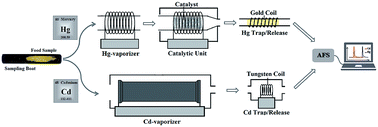当前位置:
X-MOL 学术
›
J. Anal. At. Spectrom.
›
论文详情
Our official English website, www.x-mol.net, welcomes your
feedback! (Note: you will need to create a separate account there.)
Direct determination of trace mercury and cadmium in food by sequential electrothermal vaporization atomic fluorescence spectrometry using tungsten and gold coil traps†
Journal of Analytical Atomic Spectrometry ( IF 3.1 ) Pub Date : 2018-05-10 00:00:00 , DOI: 10.1039/c8ja00009c Bo Wang 1, 2, 3, 4, 5 , Li Feng 6, 7, 8 , Xuefei Mao 1, 2, 3, 4, 5 , Jixin Liu 1, 2, 3, 4, 5 , Chongchong Yu 8, 9, 10, 11 , Lan Ding 8, 12, 13, 14 , Siqi Li 8, 15, 16 , Chuangmu Zheng 1, 2, 3, 4, 5 , Yongzhong Qian 1, 2, 3, 4, 5
Journal of Analytical Atomic Spectrometry ( IF 3.1 ) Pub Date : 2018-05-10 00:00:00 , DOI: 10.1039/c8ja00009c Bo Wang 1, 2, 3, 4, 5 , Li Feng 6, 7, 8 , Xuefei Mao 1, 2, 3, 4, 5 , Jixin Liu 1, 2, 3, 4, 5 , Chongchong Yu 8, 9, 10, 11 , Lan Ding 8, 12, 13, 14 , Siqi Li 8, 15, 16 , Chuangmu Zheng 1, 2, 3, 4, 5 , Yongzhong Qian 1, 2, 3, 4, 5
Affiliation

|
On the basis of the vaporization temperature difference principle between Hg and Cd analytes, a novel solid sampling system coupled with atomic fluorescence spectrometry (AFS) was developed for the sequential determination of trace Hg and Cd in food samples. The solid sampling system mainly comprised a gold coil trap for Hg and a tungsten coil (TC) trap for Cd to eliminate matrix interference, and an on-line Ni–Cr heating coil as the Hg electrothermal vaporizer (ETV) as well as a sample ashing furnace, and a porous carbon tube as the Cd ETV. These units were connected by a modified gas line system integrating air and Ar/H2 (v/v = 9 : 1). The optimal vaporization (500–600 °C), trapping (ambient temperature), and pre-heating conditions of the gold coil (800 °C for 14–16 s) for Hg were all investigated, as well as the sample ashing (the same as Hg vaporization), vaporization (1200 °C for 20 s), and releasing (2000 °C for 1 s) conditions for Cd at 600 mL min−1 of both air and Ar/H2 carrier gases. Under the optimum conditions, the detection limits (LODs) could reach 0.7 pg for Hg and 0.5 pg for Cd with less than 15% relative standard deviations (RSDs), namely 0.07 μg kg−1 and 0.05 μg kg−1 when introducing 10 mg sample mass, respectively. Furthermore, the spiked recoveries were 95.0–115.0% for Hg and 84.0–113.0% for Cd. The Hg and Cd concentrations measured by the proposed solid sampling method were all consistent with the certified reference material (CRM) values and those obtained by microwave digestion inductively coupled plasma mass spectrometry. The solid sampling Hg–Cd analyzer was extremely suitable for the in-field, rapid and accurate monitoring of Hg and Cd in food samples.
中文翻译:

连续电热汽化原子荧光光谱法使用钨和金线圈捕集阱直接测定食品中的痕量汞和镉†
基于汞和镉分析物之间的汽化温差原理,开发了一种新型的固体进样系统-原子荧光光谱法(AFS),用于食品中痕量汞和镉的顺序测定。固体采样系统主要包括用于汞的金线圈捕集器和用于镉的钨线圈(TC)捕集器,以消除基体干扰,以及在线Ni-Cr加热线圈作为汞电热蒸发器(ETV)以及样品灰化炉和Cd ETV等多孔碳管。这些单元通过集成了空气和Ar / H 2的改进型气体管线系统连接(v / v = 9:1)。研究了汞的最佳气化(500–600°C),捕集(环境温度)和金卷(800°C,持续14–16 s)的预热条件,以及样品灰化(与Hg气化相同),气化(1200°C持续20 s)和释放Cd在600 mL min -1的空气和Ar / H 2载气中释放Cd的条件。在最佳条件下,汞的检测限(LODs)可以达到0.7 pg,镉的检测限(LODs)可以达到0.5 pg,相对标准偏差(RSDs)小于15%,即0.07μgkg -1和0.05μgkg -1当分别引入10 mg样品质量时。此外,汞的加标回收率为95.0–115.0%,镉的加标回收率为84.0–113.0%。通过建议的固体采样方法测得的Hg和Cd浓度均与经认证的参考物质(CRM)值以及通过微波消解电感耦合等离子体质谱法获得的Hg和Cd值一致。固体采样汞镉分析仪非常适合现场,快速,准确地监测食品样品中的汞和镉。
更新日期:2018-05-10
中文翻译:

连续电热汽化原子荧光光谱法使用钨和金线圈捕集阱直接测定食品中的痕量汞和镉†
基于汞和镉分析物之间的汽化温差原理,开发了一种新型的固体进样系统-原子荧光光谱法(AFS),用于食品中痕量汞和镉的顺序测定。固体采样系统主要包括用于汞的金线圈捕集器和用于镉的钨线圈(TC)捕集器,以消除基体干扰,以及在线Ni-Cr加热线圈作为汞电热蒸发器(ETV)以及样品灰化炉和Cd ETV等多孔碳管。这些单元通过集成了空气和Ar / H 2的改进型气体管线系统连接(v / v = 9:1)。研究了汞的最佳气化(500–600°C),捕集(环境温度)和金卷(800°C,持续14–16 s)的预热条件,以及样品灰化(与Hg气化相同),气化(1200°C持续20 s)和释放Cd在600 mL min -1的空气和Ar / H 2载气中释放Cd的条件。在最佳条件下,汞的检测限(LODs)可以达到0.7 pg,镉的检测限(LODs)可以达到0.5 pg,相对标准偏差(RSDs)小于15%,即0.07μgkg -1和0.05μgkg -1当分别引入10 mg样品质量时。此外,汞的加标回收率为95.0–115.0%,镉的加标回收率为84.0–113.0%。通过建议的固体采样方法测得的Hg和Cd浓度均与经认证的参考物质(CRM)值以及通过微波消解电感耦合等离子体质谱法获得的Hg和Cd值一致。固体采样汞镉分析仪非常适合现场,快速,准确地监测食品样品中的汞和镉。











































 京公网安备 11010802027423号
京公网安备 11010802027423号